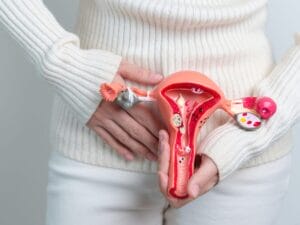Are you one of the millions who suffer from the chronic inflammatory condition endometriosis? Do you struggle to know which diet is best?
The Office on Women’s Health estimates that 6.5 million American women aged 15-44 are affected by the condition. But with an average diagnosis period of 7 years, this figure is likely to be much higher.
There is currently no known cure for endometriosis and mainstream medical care focuses on hormonal contraceptives and surgical options. These methods fail to acknowledge the influence of food, movement, and lifestyle on hormone health. So, what is endometriosis, and which diet is best?
What is endometriosis?
Endometriosis is a chronic inflammatory condition where cells similar to the ones lining the womb (endometrial cells) grow elsewhere. They can grow anywhere in the body including the lungs, brain, bowel, bladder, and digestive tract.
Each month these cells follow the same pattern as regular cells lining the womb. They grow, break down, and bleed. But unlike normal endometrial cells that leave the body via menstruation, the blood from these cells has nowhere to go. This can lead to the formation of painful cysts, scar tissue, and adhesions (tissue that binds organs together).
What causes endometriosis?
Doctors still do not know exactly what causes endometriosis but there are several theories:
Immune dysregulation: Immune cells fail to recognize and deal with the cells growing outside the womb.
Genetic predisposition: Endometriosis can run in families and there may be a genetic heritability factor to the condition (Nouri et al, 2010).
Retrograde menstruation: Menstrual blood may flow into other parts of the body and deposit womb cells.

Symptoms of endometriosis
The main symptom of endometriosis is pain which can be felt in the pelvic area, the groin, the lower abdomen, and the lower back.
Other symptoms include:
Dysmenorrhea (menstrual cramps)
Heavy or irregular bleeding
Pain during sex
Gastrointestinal disturbances such as bloating, constipation, diarrhea, nausea, and vomiting
Pain when defecating
Frequent urination and/or pain during urination
The driving force behind these symptoms is chronic inflammation and excess amounts of estrogen, produced by the endometrial tissues (Bulan et al, 2019).

Dealing with “endo belly”
“Endo belly” is the tight, bloated abdomen endometriosis sufferers experience during their monthly cycle. It can be accompanied by pain, wind, or changes in bowel habits. The bloating may get worse just before a period when hormone levels peak.
The best way of dealing with endo belly and the many other symptoms of endometriosis is through food and lifestyle changes.
What you eat and how you live influences your hormone health every single day. If you want to drive down excess estrogen and be free of inflammation you need to live more harmoniously with your hormones.
Which diet is best for endometriosis?
We believe the most effective approach for managing endometriosis is an anti-inflammatory diet that supports gut health and liver function.
This approach addresses the underlying causes of endometriosis:
Inflammation: Endometriosis is characterized by painful, inflammatory symptoms. A typical Western-style diet rich in ultra-processed foods and low in fiber and antioxidants will fuel this inflammation and make your symptoms worse.
Estrogen excess: Estrogen needs to be detoxified through the liver and excreted via the gut. The gut microbiota contains a special subset of bacteria called the estrobolome which is responsible for processing estrogen. If the estrobolome is disrupted it can recycle old estrogen back into circulation, adding to the overall hormone imbalance.
Jiang et al (2021) show that endometriosis is associated with gut microbiome disturbances which in turn lead to immune dysfunction and further inflammation. This two-way connection between endometriosis and the gut microbiome must be addressed with diet to help reduce inflammation and optimize microbial balance.
Why the EBS diet and lifestyle is best for endometriosis
At EBS we believe in a whole-body approach to managing endometriosis. Our programs encompass foods, movement, and meditation, to support health holistically.
The EBS platform is used and prescribed by healthcare professionals worldwide for endometriosis and other chronic inflammatory conditions. It treats inflammation at a systemic level, supports optimum hormone balance, and reduces pain where needed.
This is what some of our EBS members with endometriosis have to say:
“Just finished Week One and I feel great already. The main reason I’m following the EBS lifestyle is suffering endometriosis. I lost 1kg on Week One and feel less bloated. Overall, I think mentally I feel better as well!!”
Niloofar
“I have some great news that I wanted to share with you. My endometrioma finally started to shred one year after the diagnosis, and after joining the EBS, it was stable, and I thought it was never going to shred.
In February 2022 it was down by 1.5cm, and now it is down by 2.5cm! I couldn’t believe my doctor! I thought that surgery was the only way to get rid of it!
I am so happy that I finally see the healing. The brain is incredible.
I believe reducing stress, body mobility, and whole foods are keys to sustainable health.”
Safae
Ready to be free from the pain and bloating of endometriosis? Join Eat Burn Sleep today and get started on your path to a pain-free life. Take a sneak peek around the platform here and check out our membership options here.
And you might also enjoy:
The Anti-inflammatory Diet and Lifestyle
Women’s Pelvic Floor Health – Podcast
Wishing you well,
Yalda x


